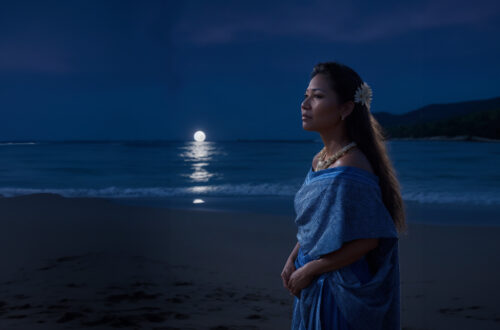
From Celestial Spirits to Inner Divinity: Our Fascination with the Supernatural and the Promise of Ho’oponopono
Allow me to take you on a journey to the heart of human understanding, where mystery and curiosity merge, and the cosmos is explained in the light of a thousand stars. In the realm of human consciousness, we are all seasoned sailors navigating the sea of reality. Much like our canine friends who bark at the howling wind or chimps that break sticks to confront a thunderstorm, we too seek to make sense of the world around us.
Enter Ho’oponopono, an ancient Hawaiian practice that doesn’t seek to explain why things happen, but instead presents a unique perspective of the human psyche. It proposes that a creative divine force, the very essence of nature’s potentiality, plays a significant role in our lives.
But before we delve deeper, let’s expand our horizons a bit.
Historically, we humans have used supernatural explanations to make sense of the world. A recent study published in Nature Human Behaviour explored this phenomenon across 114 nonindustrial societies. The findings are as fascinating as they are revealing:
Supernatural explanations were abundant for natural phenomena. Consider the Kapauku people of modern-day Indonesia, who believed stars to be the glowing ends of celestial spirits’ cigarettes or attributed earthquakes to a mythical creature’s thumping tail.
Supernatural reasoning was also attributed to social events. The Thonga people, for instance, believed in a medicine called “nyokwekulu,” which ferments to alert the community of imminent war.
Intriguingly, supernatural explanations were more common for natural events than social ones. This pattern was observed across all societies surveyed, with a higher frequency of supernatural explanations for disease, food scarcity, and natural hazards than for warfare, murder, or theft.
But why this penchant for supernatural explanations, especially for natural phenomena? The absence of clear, identifiable agents behind these events might be the key.
It’s a fascinating human trait: we tend to personify the world around us. We attribute events to a responsible agent acting with intent. When tragedy strikes and there’s no clear person to blame, our gaze turns skyward, seeking answers in the divine.
There are several theories as to why this personification occurs:
We are social creatures: Much of our thought process is dedicated to understanding each other’s intentions. When there’s no clear source of intent, we feel the urge to create one.
Survival instinct: It could be a threat detection device—an evolutionary result of our ancestors’ need to see the world as “alive.”
The animal kingdom resonates: Even animals show a bias to see nature as alive.
Now, supernatural explanations for social phenomena were less common, yet they still existed, particularly in larger, more urbanized societies. Why? Well, there are a few possible reasons:
People living in larger societies might simply be more concerned about warfare, theft, and murder.
Larger societies may have more religious professionals promising supernatural influence over social phenomena.
High levels of distrust in larger societies can lead to beliefs about supernatural misdeeds.In essence, the findings reveal that people often seek supernatural explanations for events lacking clear human origins. This tendency to supernaturalize the natural world suggests that the earliest human religious beliefs were attempts to grapple with the mysteries of nature.
This has implications for contemporary debates too. For instance, deeply religious individuals’ scepticism of man-made climate change might be rooted in the belief that God is the ultimate architect of climate and weather. These beliefs underline how supernatural explanations persist even in industrialized societies and can potentially become a roadblock for human intervention.
In light of all this, Ho’oponopono stands as a unique approach. It doesn’t seek to offer a unified theory of the universe, nor does it promise magical answers.
Instead, it invites us on a journey of self-discovery, where we acknowledge the creative divinity within us. It’s an approach that, rather than seeking to make sense of the world through supernatural explanations, encourages us to delve into the deepest recesses of our psyche.
Ho’oponopono posits that we each hold a piece of the divine within us, that the same force powering the cosmos is present in our hearts. This philosophy promotes understanding through introspection, by tapping into our inner divinity rather than attributing events to external supernatural forces.
So, when life throws you a curveball, when the unexpected or the unpleasant manifests, consider the wisdom of Ho’oponopono. Embrace the notion that the divine, the supernatural, is not a distant entity controlling events, but a part of us, shaping our reality through our thoughts, actions, and intentions.
Remember, as we navigate through life, the compass guiding us isn’t always found in the stars above but often within the depths of our own hearts.
In conclusion, whether we turn to the divine to explain the inexplicable or delve within ourselves for answers, the pursuit of understanding remains a profoundly human endeavour. As we continue this journey, let us remember that every answer we seek, every mystery we wish to unravel, starts with us.
As we continue to explore the vast cosmos of our minds and what appears as a world around us, let’s remember that, sometimes, the most profound answers aren’t found in the external world but within us. Whether it’s the ancient wisdom of Ho’oponopono or the collective beliefs of our ancestors, they all point towards one undeniable truth – we are intimately connected to the universe, and within us lies the potential to understand and shape our reality.


You May Also Like

Transcending Reality with Ho’oponopono: A Journey Beyond Perception

Ho’oponopono: A Deep Dive into a Powerful Healing Modality
